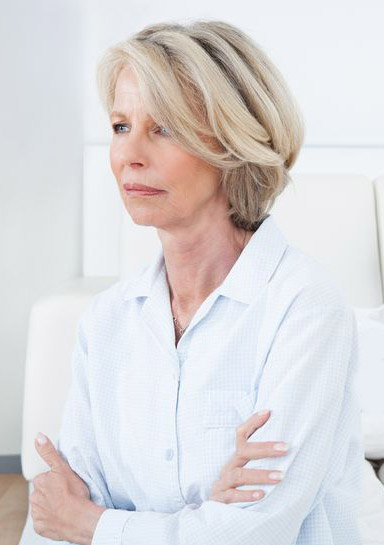“I’m not myself anymore…”
What is Menopause?
The start of the reproductive cycle in a woman is called menarche. It is when the eggs in her ovaries make estrogen and progesterone and begin to ovulate leading to regular periods. This happens in the teen years. After menarche, hormone levels can fluctuate for months, even years before regular periods are established. The reproductive cycle ends when the remaining eggs cannot make enough of these hormones so ovulation does not occur and periods stop. This is usually around the age of 50, which is called menopause.
What is Perimenopause?
Prior to menopause the same fluctuating hormone levels that occurred during the teen years happen again, periods become irregular and women begin to experience menopausal symptoms, which is called perimenopause. Generally these symptoms begin in the late 40’s however some women will start having symptoms in their 30’s. During this time, menopausal symptoms, such as those listed below, can have significant negative effects on a woman’s quality of life.
“One minute I’m in control and the next minute, I feel completely crazy.”
What are the Symptoms of Perimenopause and Menopause
- Irregular Bleeding

- Hot flashes
- Night Sweats
- Trouble Sleeping
- Vaginal dryness and/or painful intercourse
- Increased frequency and urgency of urination
- Mood Swings, irritability and/or crying at the drop of a hat
- Loss of interest in sex
- Slowed metabolism leading to the inability to lose weight or weight gain
- Thinning hair
- Dry skin
Treatments For Menopause
When exploring treatments for menopausal symptoms, it is important to understand the history and research of Hormone Replacement Therapy (HRT). Women were first given estrogen for menopausal symptoms in 1943 in the form of Premarin, a product containing several estrogen compounds made from pregnant horse urine. They were generally given estrogen for their symptoms until a study in 1975 showed, when given only estrogen, they had an increased risk of uterine cancer. Since then, women are given only estrogen if they have had a hysterectomy. Women who still have their uterus receive estrogen and progesterone or a synthetic progestin. The progesterone protects them from the effects of estrogen in the uterus and significantly lessens the risk of uterine cancer.
In 2002 the Women’s Health Initiative Study (WHI) indicated a possible increased risk of heart disease and breast cancer in women taking estrogen and progestin in the form of Prempro. Many women stopped HRT, or are reluctant to start HRT because of the press surrounding the WHI study. Since that time there has been significant controversy about the study and the validity of the results have been called into question.
“I believe every woman should hear all of the information available, explore treatment options, and make an educated decision about what’s best for her. Not a decision based on fear or misinformation.” – Dr. Kim Lane
Hormone Replacement Therapy – Systemic Treatments
Systemic treatments are aimed at relieving all of the menopausal symptoms listed above.
Systemic treatments can be estrogen or estrogen/progesterone combinations including pills, patches, creams or pellets that may be bio-identical or non-bio-identical.
Hormone Replacement Therapy – Localized Treatments
Localized treatments are aimed at relieving symptoms such as:
- Vaginal dryness and/or painful intercourse
- Increased frequency and urgency of urination
Options can be estrogen creams, suppositories, rings or pills applied to the vulva or inserted into the vagina.
Both systemic and localized treatments can be bio-identical and produced by a pharmaceutical company and compounded by a pharmacy.
MonaLisa Touch Laser Treatment
The MonaLisa Touch laser can also be used to treat vaginal dryness and discomfort. It is a CO2 laser that stimulates collagen, elastin and neovascularization which recreates the thicker tissue seen before menopause. Patients experience significant improvement in dryness, pain, itching, painful urination and painful intercourse.
discomfort. It is a CO2 laser that stimulates collagen, elastin and neovascularization which recreates the thicker tissue seen before menopause. Patients experience significant improvement in dryness, pain, itching, painful urination and painful intercourse.
It can be used as a localized treatment, and it can also be incorporated into a treatment plan for all of your menopausal symptoms.
“I was diagnosed with breast cancer at age 29 and went through surgeries, chemotherapy and radiation. Once I started tamoxifen I began experiencing vaginal dryness and atrophy leading to painful intercourse… This treatment is life changing… After that first treatment, I had results almost immediately. I would say, go for this, because this will fix it!” – Lisa, March 2015
Non-Hormonal Treatments
Non hormonal treatments can relieve all of the above symptoms except for irregular bleeding.
Options can be antidepressants (some can relieve hot flashes), sleep medications (prescription or over-the-counter), lubricants, medications for urinary symptoms, supplements such as Serenol and Relizen.
Lifestyle Treatments
Lifestyle treatments can help decrease most menopausal symptoms. These include:
- Healthy Diet – Eliminate diet related triggers such as caffeine and red wine
- Regular Exercise
- Stress Relieving Activities
- Good Sleep Habits
Menopausal symptoms can be annoying for some women, but in others it can seriously effect the quality of their lives. Dr. Lane encourages all women to explore the treatment options most appropriate for their symptoms.
